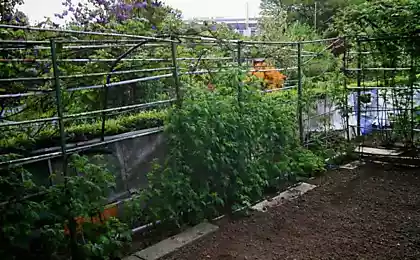853
Badan in your garden: species, planting and care
One of the popular names - "elephant's ear" - saxifrage received for the shape and size of leaves - large, rounded, leathery. From autumn cold "elephant ears" razrumyanivayutsya and sometimes blush, like leaves on trees. Beauty!
The small genus Badanov saxifrage family has no more than a dozen species. This low-growing perennial plants that live in the forests, alpine meadows, on rocks and scree. Most of the species are concentrated in the mountains of the Himalayas and China. Some species are raised in the mountains to a height of over 4,000 m!
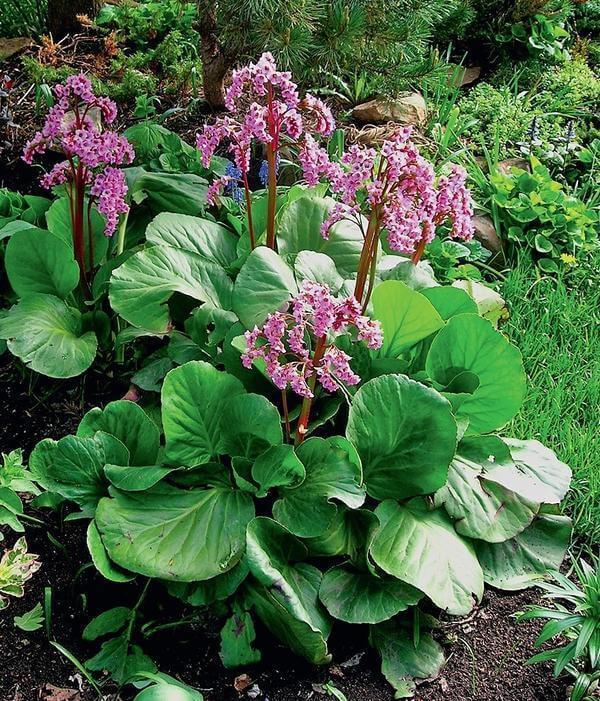
When redden the ears of an elephant?
Badal decorative from spring to late autumn. In the spring of this spectacular Flowering plants, summer magnificent carpet of green leaves they gallantly set off the beauty of other flowers, and at the end of the season due to the autumn coloring are again in the spotlight.
Badan - a plant winter-green, the leaves do not die off in the fall, and the charming red and preserved under the snow until spring. In some varieties turn red only veins and the edge of the sheet, while others -. The entire sheet as a whole, showing different shades of purple, bronze and fire
In nature, dark green leaves, but among the varieties there are plants that stand out purple and bronze coloration, not only in the fall, but in the rest of the year. Add to them, and fancy golden green Badal. One only elegant leaves would already be enough to consider saxifrage magnificent ornamental plant. But he is also in bloom!
Bergenia flowers resemble small pink, crimson or white bells. They are collected in corymbose inflorescences branched on direct thick legs. Interestingly, in the beginning of flowering stalks very short, flowers in pink "piles" are among the leaves, but every day the stems rise higher and elongate inflorescence branches. Finally, the flower stalks straightened to his full height, and beautifully curls inflorescences bend downward. At this time, they look like tiny pink palmochki who grew up among the giant lacquered lopushkov. (This is why the same variety may look different, depending on whether the beginning or the end of the flowering plant is photographed).
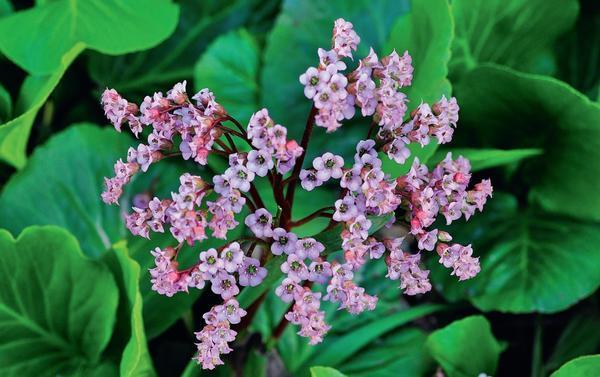
Species and varieties
At the end of April, when the bloom earliest Badal - serdtselistny and crassifolia, garden filled with colors not only on color, but also from the bright butterflies fly to Badane for nectar. Such abundant sources of nectar in early spring a little, and overwintered pavlinoglazki and limonnitsy and then go and see the flowers. One inflorescence can be found up to two or three at a time of bright butterflies. And bumblebees do not even wait for the flowers unfold fully. They manage to get the nectar through a tiny hole in the center of the bud as soon as petals begin to diverge in hand.
Some varietal Badal, eg 'Rosi Klose', have a longer flowering. Late Badal 'Overture', 'Eroica', 'Beethoven' bloom until June, and such varieties as 'Abendglocken', 'Andrea', 'Morgenrote', 'Pink Dragonfly', to the delight of the butterflies, bumblebees and bees bloom in late summer again. Early flowering Badanov possible because the flower stalks are incorporated in the kidney since the autumn. By the end of flowering begins to grow and young leaves.
Despite all the charm of Bergenia, many have yet to discover this plant. Before our gardens modern varietal diversity gets slow. We often judge Badane for those plants that are seen in a neighboring garden, while there are many spectacular novelties.
Pink bells Bergenia new varieties represented an unusually wide range. The flowers are pinkish-white as the apple flowers, crimson and purple-red like fuchsia. Interesting nuances creates an coloring calyx and stems, for example, in a contrasting combination of bright flower corolla with dark ruby red cups and stems. Grades can also be very different sizes of leaves - from giants like 'Ballawley' or 'Eden's Magic Giant' height of about 60 cm to small compact plant varieties 'Wintermarchen', 'Dark Damsel', 'Baby Doll' and 'Angel Kiss'
In our gardens often spread Siberian Badal serdtselistny (Vergenia cordifolia) and tolstolisty (Vergenia crassifolia). A great variety in modern range made Pamir saxifrage Strachey (Vergenia stracheyi) and Himalayan saxifrage ciliated (Vergenia ciliate). Badan Strachey attracts tiny size, its height is only 15 cm. In floriculture as a proliferation of forms and Afghanica Alba. Badan ciliated interesting unusual leaves. They are not glossy, and bristly, and this creates special opportunities for design: cilia collect dew. Extremely elegant Chinese mountain saxifrage omeysky (Bergenia omeiensis). Just open flowers in his pure white, by the end of flowering, they slightly turn pink.
Site selection and planting
For Badane its fame as shade tolerance and open sunny places gets them in the gardens often. However, you need to choose a place depending on the desired result. In the penumbra, where the soil retains moisture longer, saxifrage grows juicy carpet, but not as spectacular blooms. In the sun, it will impress you with magnificent blooms but lush green carpet in the shade, most likely, will not. In the sun, these plants need watering.
Soil for Bergenia much irrelevant. Nevertheless, the most effect but the plants seem to moderately fertile garden soil treated, cleared of weeds. If before boarding you get rid of goutweed rootstocks and other perennial weeds, further saxifrage and did not miss in its thicket of undesirable aliens. Its leaves are closed and jammed random shoots.
It is very important for Bergenia drainage because stagnant water plants can not bear.
When creating large groups of plants are planted at a distance of about 40 cm from each other, as the rhizomes growing need to provide enough space for the branch.
Care Badane
In nature, the old blackened Bergenia leaves accumulate around the plant and serve as a natural mulch. In the garden, we prefer the neat appearance of landings, so get rid of old leaves in spring, as a result of the soil under the plants dry out quickly. To compensate the damage caused to the plant we can, mulching the soil under Badane decorative wood chips, bark and other materials of our choice. In addition, from time to time it is useful to mulch the plant and leaf humus or compost.
Reproduction
Bergenia Reproduction is possible by dividing the bush, cuttings and seeds. For rooting is best to choose a part of the rhizome with the apical bud. The outlet is left 2-3 young leaf, the rest removed. Planted cuttings to a depth of 3-5 cm. The best time for grafting comes immediately after flowering and lasts until August. Plants bloom from cuttings in the second or third year.
Divide the bushes in early September. The most difficult to propagate by seed saxifrage. They are small, the seedlings grow slowly, requiring the most attentive care. Therefore resorted to seed reproduction makes sense only if the natural breeding of rare species, or for breeding purposes. Seedlings bloom with good care on the 3-4th year.
Possible problems
Where saxifrage on his own, with bushes accumulated in their old leaves become a refuge for the snails. If the spring gently remove all the old blackened leaves saxifrage ceases to attract snails and looks much more attractive.
Badan in garden design
Creeping growth form suggests where saxifrage can express themselves well. It is planted in the foreground of flower beds, along the tracks, in front of large groups of shrubs and evergreen as a groundcover under trees.
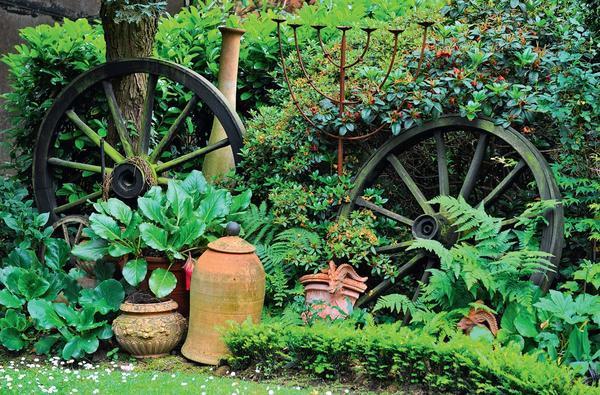
Very good Badal in rocky gardens and in compositions with conifers. It is often so they grow in nature. Forming picturesque thickets, saxifrage can become successful in some places, and the replacement of the lawn, do not require mowing. Compact miniature Badal for small slides.
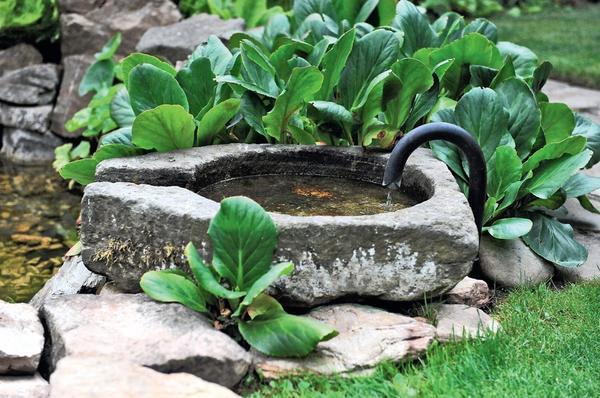
Planted the plants and gravel gardens, and on the banks of reservoirs. Unpretentious and winter hardiness of many varieties allow Badan used in a variety of design options, the sun, in the shade and on poor stony soils. Varieties with high peduncles are suitable for cutting. Good Badal and container compositions, especially for shady places.
Author: I. Volkovskaya. Photo: S. Kalyakin, S. Kovalenko.
The small genus Badanov saxifrage family has no more than a dozen species. This low-growing perennial plants that live in the forests, alpine meadows, on rocks and scree. Most of the species are concentrated in the mountains of the Himalayas and China. Some species are raised in the mountains to a height of over 4,000 m!

When redden the ears of an elephant?
Badal decorative from spring to late autumn. In the spring of this spectacular Flowering plants, summer magnificent carpet of green leaves they gallantly set off the beauty of other flowers, and at the end of the season due to the autumn coloring are again in the spotlight.
Badan - a plant winter-green, the leaves do not die off in the fall, and the charming red and preserved under the snow until spring. In some varieties turn red only veins and the edge of the sheet, while others -. The entire sheet as a whole, showing different shades of purple, bronze and fire
In nature, dark green leaves, but among the varieties there are plants that stand out purple and bronze coloration, not only in the fall, but in the rest of the year. Add to them, and fancy golden green Badal. One only elegant leaves would already be enough to consider saxifrage magnificent ornamental plant. But he is also in bloom!
Bergenia flowers resemble small pink, crimson or white bells. They are collected in corymbose inflorescences branched on direct thick legs. Interestingly, in the beginning of flowering stalks very short, flowers in pink "piles" are among the leaves, but every day the stems rise higher and elongate inflorescence branches. Finally, the flower stalks straightened to his full height, and beautifully curls inflorescences bend downward. At this time, they look like tiny pink palmochki who grew up among the giant lacquered lopushkov. (This is why the same variety may look different, depending on whether the beginning or the end of the flowering plant is photographed).

Species and varieties
At the end of April, when the bloom earliest Badal - serdtselistny and crassifolia, garden filled with colors not only on color, but also from the bright butterflies fly to Badane for nectar. Such abundant sources of nectar in early spring a little, and overwintered pavlinoglazki and limonnitsy and then go and see the flowers. One inflorescence can be found up to two or three at a time of bright butterflies. And bumblebees do not even wait for the flowers unfold fully. They manage to get the nectar through a tiny hole in the center of the bud as soon as petals begin to diverge in hand.
Some varietal Badal, eg 'Rosi Klose', have a longer flowering. Late Badal 'Overture', 'Eroica', 'Beethoven' bloom until June, and such varieties as 'Abendglocken', 'Andrea', 'Morgenrote', 'Pink Dragonfly', to the delight of the butterflies, bumblebees and bees bloom in late summer again. Early flowering Badanov possible because the flower stalks are incorporated in the kidney since the autumn. By the end of flowering begins to grow and young leaves.
Despite all the charm of Bergenia, many have yet to discover this plant. Before our gardens modern varietal diversity gets slow. We often judge Badane for those plants that are seen in a neighboring garden, while there are many spectacular novelties.
Pink bells Bergenia new varieties represented an unusually wide range. The flowers are pinkish-white as the apple flowers, crimson and purple-red like fuchsia. Interesting nuances creates an coloring calyx and stems, for example, in a contrasting combination of bright flower corolla with dark ruby red cups and stems. Grades can also be very different sizes of leaves - from giants like 'Ballawley' or 'Eden's Magic Giant' height of about 60 cm to small compact plant varieties 'Wintermarchen', 'Dark Damsel', 'Baby Doll' and 'Angel Kiss'
In our gardens often spread Siberian Badal serdtselistny (Vergenia cordifolia) and tolstolisty (Vergenia crassifolia). A great variety in modern range made Pamir saxifrage Strachey (Vergenia stracheyi) and Himalayan saxifrage ciliated (Vergenia ciliate). Badan Strachey attracts tiny size, its height is only 15 cm. In floriculture as a proliferation of forms and Afghanica Alba. Badan ciliated interesting unusual leaves. They are not glossy, and bristly, and this creates special opportunities for design: cilia collect dew. Extremely elegant Chinese mountain saxifrage omeysky (Bergenia omeiensis). Just open flowers in his pure white, by the end of flowering, they slightly turn pink.
Site selection and planting
For Badane its fame as shade tolerance and open sunny places gets them in the gardens often. However, you need to choose a place depending on the desired result. In the penumbra, where the soil retains moisture longer, saxifrage grows juicy carpet, but not as spectacular blooms. In the sun, it will impress you with magnificent blooms but lush green carpet in the shade, most likely, will not. In the sun, these plants need watering.
Soil for Bergenia much irrelevant. Nevertheless, the most effect but the plants seem to moderately fertile garden soil treated, cleared of weeds. If before boarding you get rid of goutweed rootstocks and other perennial weeds, further saxifrage and did not miss in its thicket of undesirable aliens. Its leaves are closed and jammed random shoots.
It is very important for Bergenia drainage because stagnant water plants can not bear.
When creating large groups of plants are planted at a distance of about 40 cm from each other, as the rhizomes growing need to provide enough space for the branch.
Care Badane
In nature, the old blackened Bergenia leaves accumulate around the plant and serve as a natural mulch. In the garden, we prefer the neat appearance of landings, so get rid of old leaves in spring, as a result of the soil under the plants dry out quickly. To compensate the damage caused to the plant we can, mulching the soil under Badane decorative wood chips, bark and other materials of our choice. In addition, from time to time it is useful to mulch the plant and leaf humus or compost.
Reproduction
Bergenia Reproduction is possible by dividing the bush, cuttings and seeds. For rooting is best to choose a part of the rhizome with the apical bud. The outlet is left 2-3 young leaf, the rest removed. Planted cuttings to a depth of 3-5 cm. The best time for grafting comes immediately after flowering and lasts until August. Plants bloom from cuttings in the second or third year.
Divide the bushes in early September. The most difficult to propagate by seed saxifrage. They are small, the seedlings grow slowly, requiring the most attentive care. Therefore resorted to seed reproduction makes sense only if the natural breeding of rare species, or for breeding purposes. Seedlings bloom with good care on the 3-4th year.
Possible problems
Where saxifrage on his own, with bushes accumulated in their old leaves become a refuge for the snails. If the spring gently remove all the old blackened leaves saxifrage ceases to attract snails and looks much more attractive.
Badan in garden design
Creeping growth form suggests where saxifrage can express themselves well. It is planted in the foreground of flower beds, along the tracks, in front of large groups of shrubs and evergreen as a groundcover under trees.

Very good Badal in rocky gardens and in compositions with conifers. It is often so they grow in nature. Forming picturesque thickets, saxifrage can become successful in some places, and the replacement of the lawn, do not require mowing. Compact miniature Badal for small slides.

Planted the plants and gravel gardens, and on the banks of reservoirs. Unpretentious and winter hardiness of many varieties allow Badan used in a variety of design options, the sun, in the shade and on poor stony soils. Varieties with high peduncles are suitable for cutting. Good Badal and container compositions, especially for shady places.
Author: I. Volkovskaya. Photo: S. Kalyakin, S. Kovalenko.



















